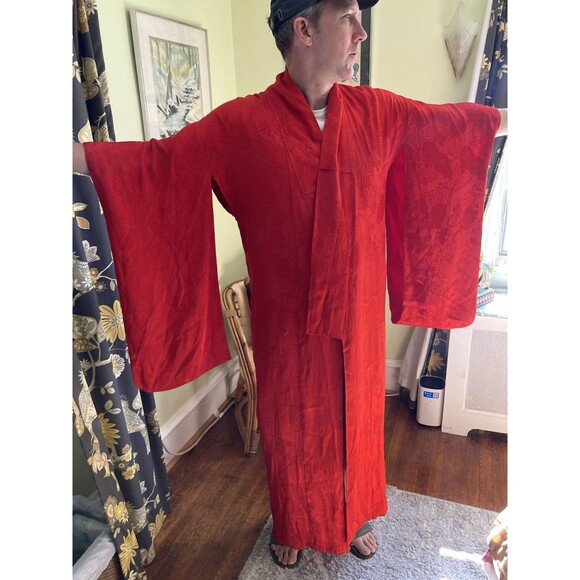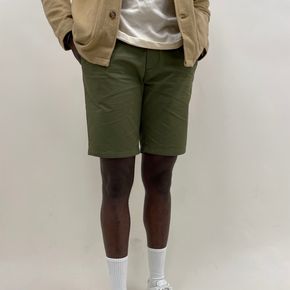Red w/ Birds Japanese Kimono Men's/Women's Silk Vintage Traditional Wear yukata
$65
Size
Like and save for later
Add To Bundle
Im selling three mens kimonos separately. The person who gave it to me said they were from 1960s Japan. Possibly 1950s, she bought them after World War II.
This one is definitely 100% silk. Really cool outer fabric with the print of swirls and birds and floral flourishes. And another inner silk lining. As you can see the edges or hand stitched, uneven, which is the style. This has a few tiny snagsto the fabric, which I really only saw upon close inspection. Its quite heavy and hangs on the body very nicely. I see no stains or major problems.
This is a mens because the model is 6 1 and this is actually floor length for him.
I have not tried to clean this piece at all. As you can see, there are a few brown spots. These look like aged spots that come on a lot of materials. OxiClean would probably clear this right up, but I will leave that up to the new buyer.
Shipping/Discount
12 Comments

epru2869
Hello! So this is actually a women's kimono. Specifically a juban, an undergarment. The length of a kimono does not determine gender, construction does, along with colors and motifs. Long sleeves and opening under the arms for example are mainly found on woman's garments. A kimono is as long as a person is tall, and the excess length is then tucked up and held in place by the obi (sash) to create a peplum-like fold.
Sep 19Reply

epru2869
Also, NEVER use oxiclean with silk, especially old silk like this. Oxyclean is a type of oxygen bleach, and will completely destroy it. I'm a textile conservator and collect and wear kimono, and I've seen pieces damaged by improper cleaning. White vinegar gets out the spots quite easily.
Sep 19Reply

alrightalex1
@epru2869 interesting. Thanks! Must either be meant to pool on the floor or for a very tall woman - the model is over 6’ tall.
Sep 20Reply

alrightalex1
Ah I read the rest- it’s meant to Billow over the belt. Bc they didn’t use belt loops I never find the belts w/ the kimonos.
Sep 20Reply

alrightalex1
@epru2869 how can u tell which is mens or women’s ? I was told these are mens by the Japanese person who gave them to me
Sep 20Reply

epru2869
@alrightalex1 How strange. The sleeve length is a dead giveaway, along with the floral motifs on this juban and the purple one, and the location of the design on the black ones you had up. Look up kurotomesode for those two.
Sep 20Reply

epru2869
@alrightalex1 These longish, swinging sleeves were very popular pre-WWII. The openings under the arms are both practical for ventilation and as a dressing aid, letting the wearer smooth out the layers beneath. Men's kimono have the sleeves directly attached to the body, no gap under the arm, because they don't have the little fold under the belt, and don't need opening to smooth everything out.
Sep 20Reply

epru2869
As for why you can never find the belts with the kimono, its because they are two seperate garments. Obi are mixed and matched with different kimono to create different outfits, and then tied different ways to create a dozen more. You can't wear a kimono traditionally without one and other accompanying accessories/layers. The garment won't hold together without them.
Sep 20Reply

alrightalex1
@epru2869 so why no belt loops ? The o I has always been lost whenever I find a kimono
Sep 20Reply

epru2869
@alrightalex1 There are no belt loops because these aren't like bathrobes. The obi is less like a belt and more like a sash. Its a stiff, heavy material that is wrapped tight around the body to hold the kimono closed. The obi is very long, so as the material is wrapped around itself, it's able to hold itself up. While there are some Japanese garments with ties sewn directly on the garment to close them, kimono aren't one of them.
Sep 20Reply

epru2869
@alrightalex1 If you sell kimono occasionally, I highly recommend watching a video or two by Billy Matsunaga on YouTube. She’s a licensed kimono teacher in Japan, and her videos are quick and informative. She has a video on dressing oneself in kimono titled "How to put on a kimono by yourself" where she explains all the layers of the garment and how it works.
Sep 20Reply

alrightalex1
@epru2869 I will- I
Love learning about fashion.
Many thanks. But because I never ever have the obi with it, it’s easy to put on :/
Sep 20Reply
Trending Now
Find Similar Listings
Account is under Review
Comment posting is temporarily restricted. Our team will reach out to you shortly. To understand why, select
Learn More.






























